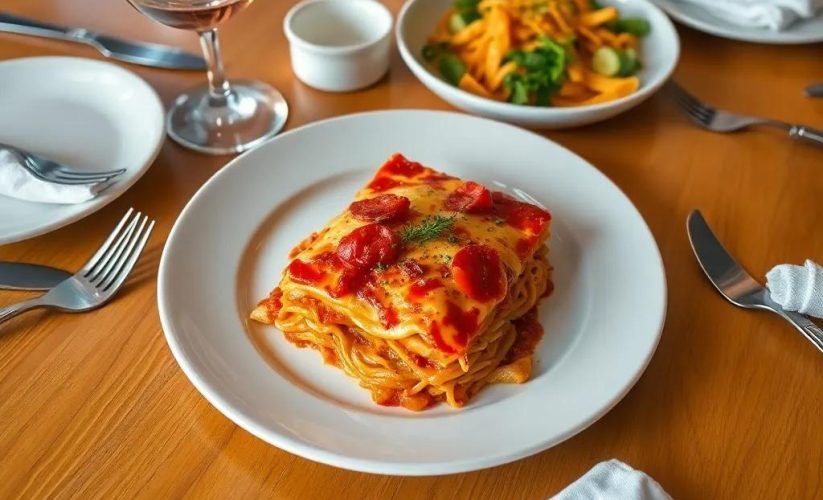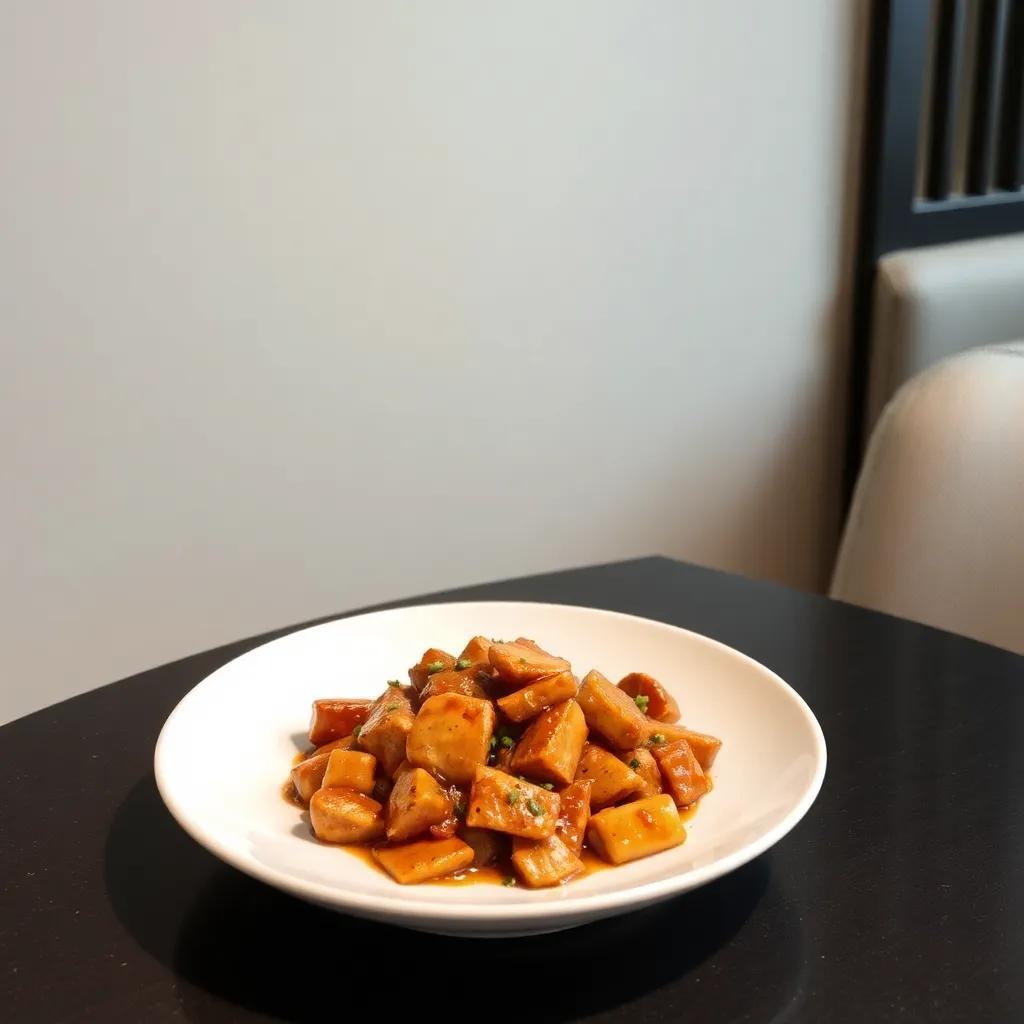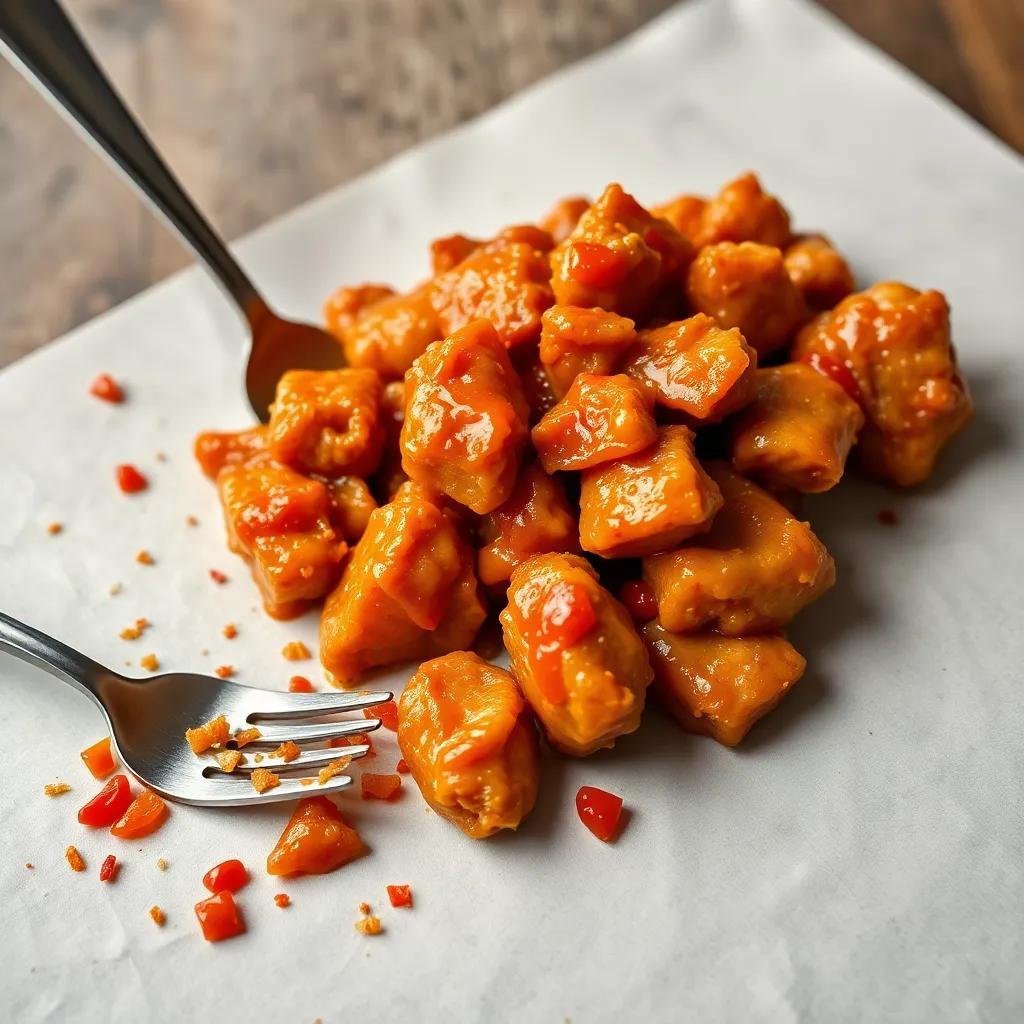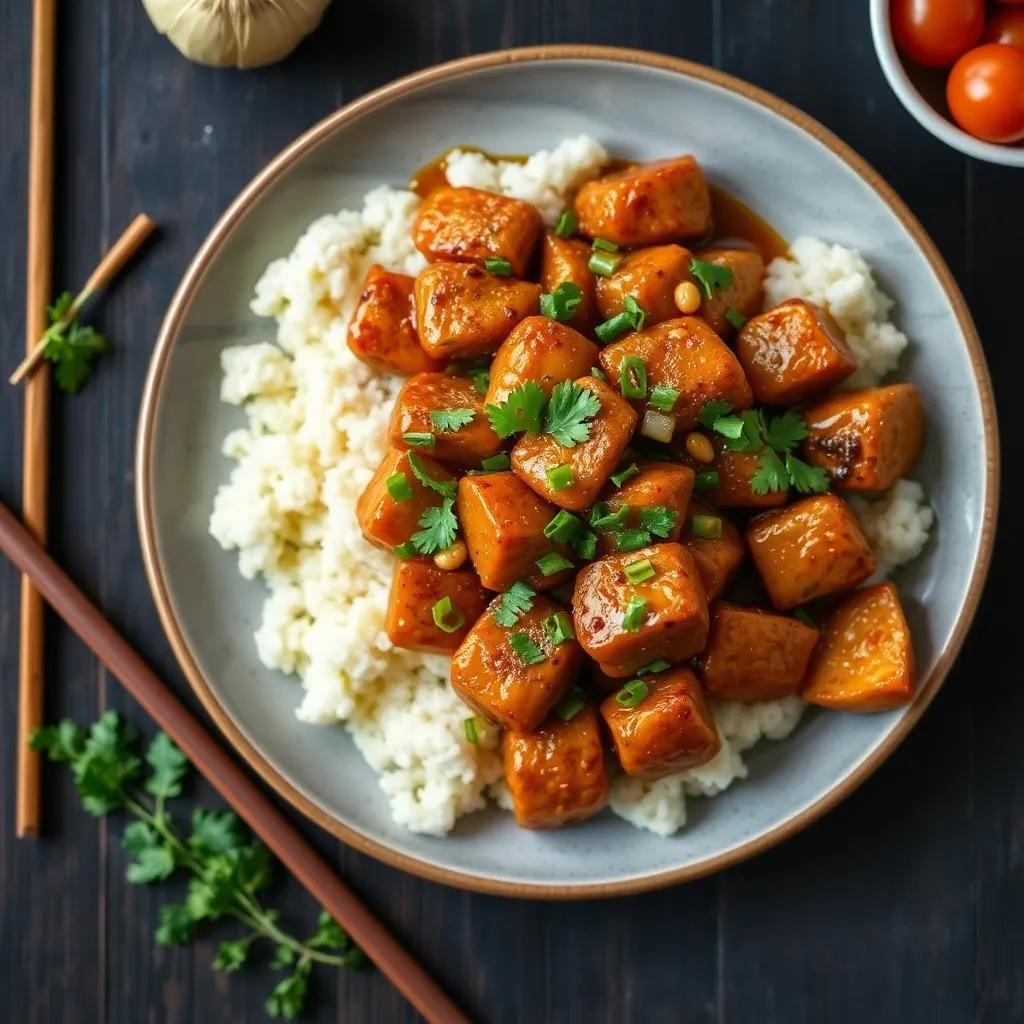30-Minute Lo Mein Recipe: Easy, Flavorful, and Kid-Friendly!
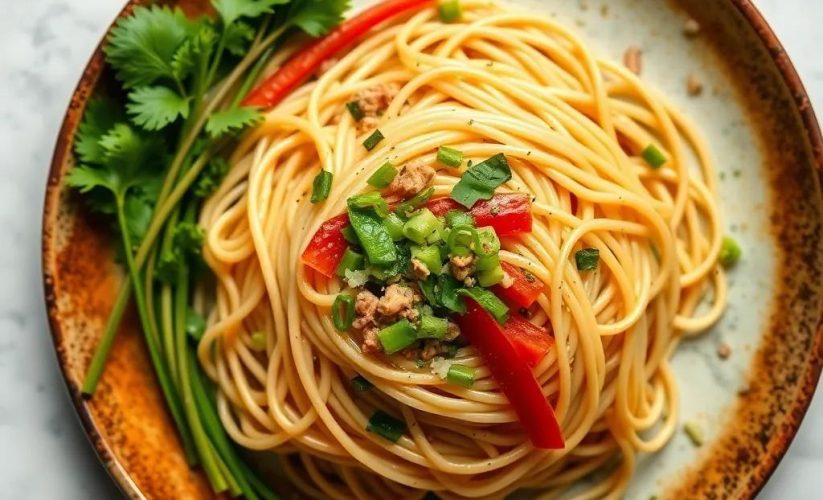
30-Minute Lo Mein Recipe: Easy, Flavorful, and Kid-Friendly!
🌍 Cuisine: Chinese
⚙️ Difficulty: Easy
Ingredients
Nutrition Facts
450
Instructions
- Cook lo mein noodles according to package instructions until al dente. Drain and rinse under cold water. Set aside.
- In a large skillet or wok, heat vegetable oil over medium-high heat.
- Add minced garlic and cook for about 30 seconds until fragrant, stirring to avoid burning.
- Add shredded carrots, sliced bell peppers, and snap peas. Stir-fry for 3-4 minutes until vegetables are crisp-tender.
- If using eggs, push vegetables to the side of the pan and pour beaten eggs into the cleared space. Scramble until fully cooked, then mix with vegetables.
- Add the cooked noodles to the skillet, tossing to combine with vegetables and eggs.
- Pour in soy sauce, oyster sauce, hoisin sauce, and toasted sesame oil. Stir well to evenly coat all ingredients.
- Sprinkle crushed red pepper flakes if using, and season with salt and pepper to taste.
- Cook for another 2-3 minutes, stirring frequently until everything is heated through.
- Remove from heat and stir in chopped green onions for freshness.
- Serve hot and enjoy your quick and flavorful Lo Mein!
Serving Suggestions
- Serve as a main dish alongside steamed dumplings or spring rolls.
- Add cooked chicken, beef, or tofu for extra protein.
- Top with chopped peanuts or toasted sesame seeds for added texture.
- Pair with a light Asian cucumber salad for a refreshing contrast.
- Drizzle extra soy sauce or chili oil for those who like more flavor or heat.
- Include a side of steamed broccoli or bok choy to add more greens.
- Reheat leftovers with a splash of water or broth to keep noodles moist.
Table of Contents
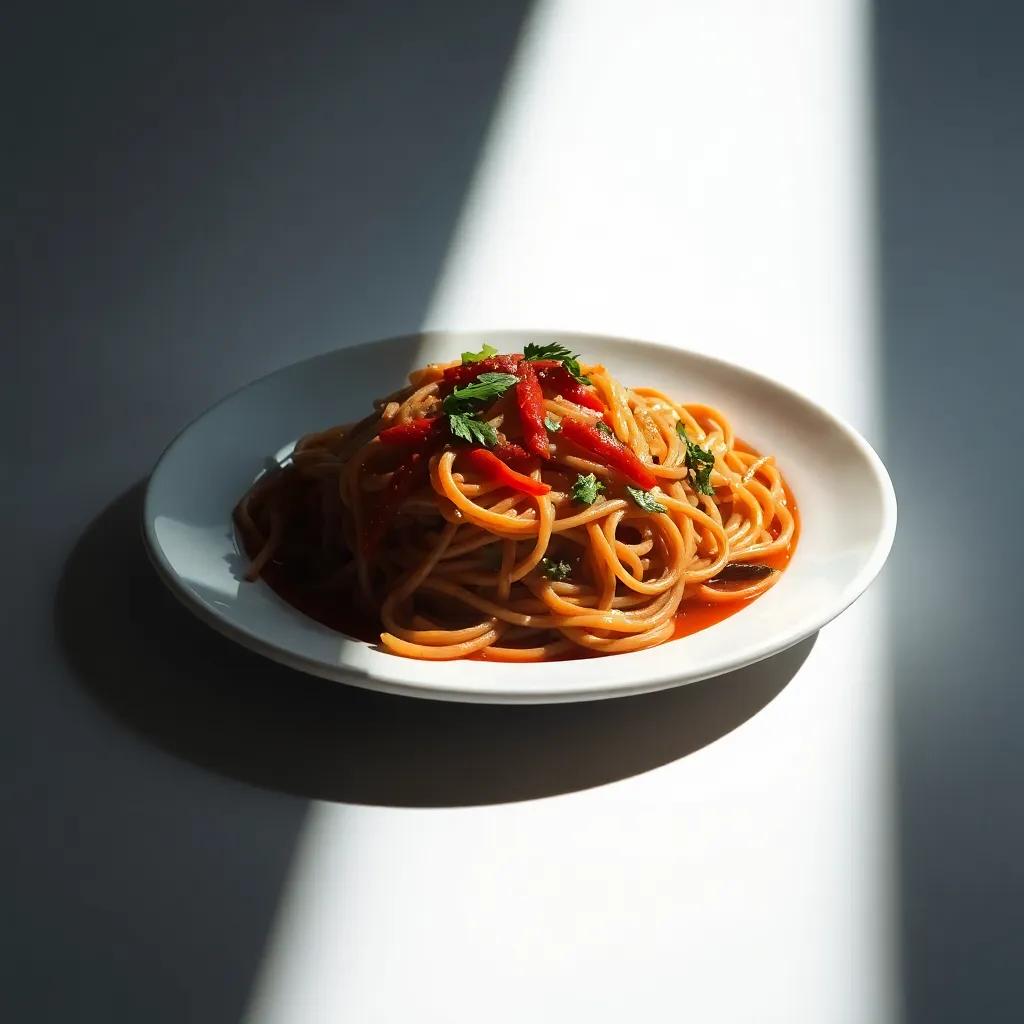
Intro
There’s something truly satisfying about a homemade Lo Mein that comes together quickly without compromising on taste or texture. This 30-minute Lo Mein recipe strikes the perfect balance between effortless weeknight cooking and a dish the whole family can enjoy. Whether you’re rushing home after a busy day, feeding picky eaters, or craving a comforting yet vibrant meal, this recipe delivers with its inviting aroma, colorful veggies, and that signature glossy sauce coating every strand of noodle.
What makes this dish exciting to make is how versatile and forgiving it is—you can easily swap ingredients to suit what’s on hand or your personal preferences, making it ideal for both novice cooks and kitchen veterans. It’s also an excellent choice for casual dinners, lunchboxes, or even small gatherings where you want to serve something familiar but flavorful. In short, this Lo Mein is your go-to pantry-friendly recipe that feels special without the fuss, bringing a taste of Chinese-inspired comfort to your plate in under half an hour.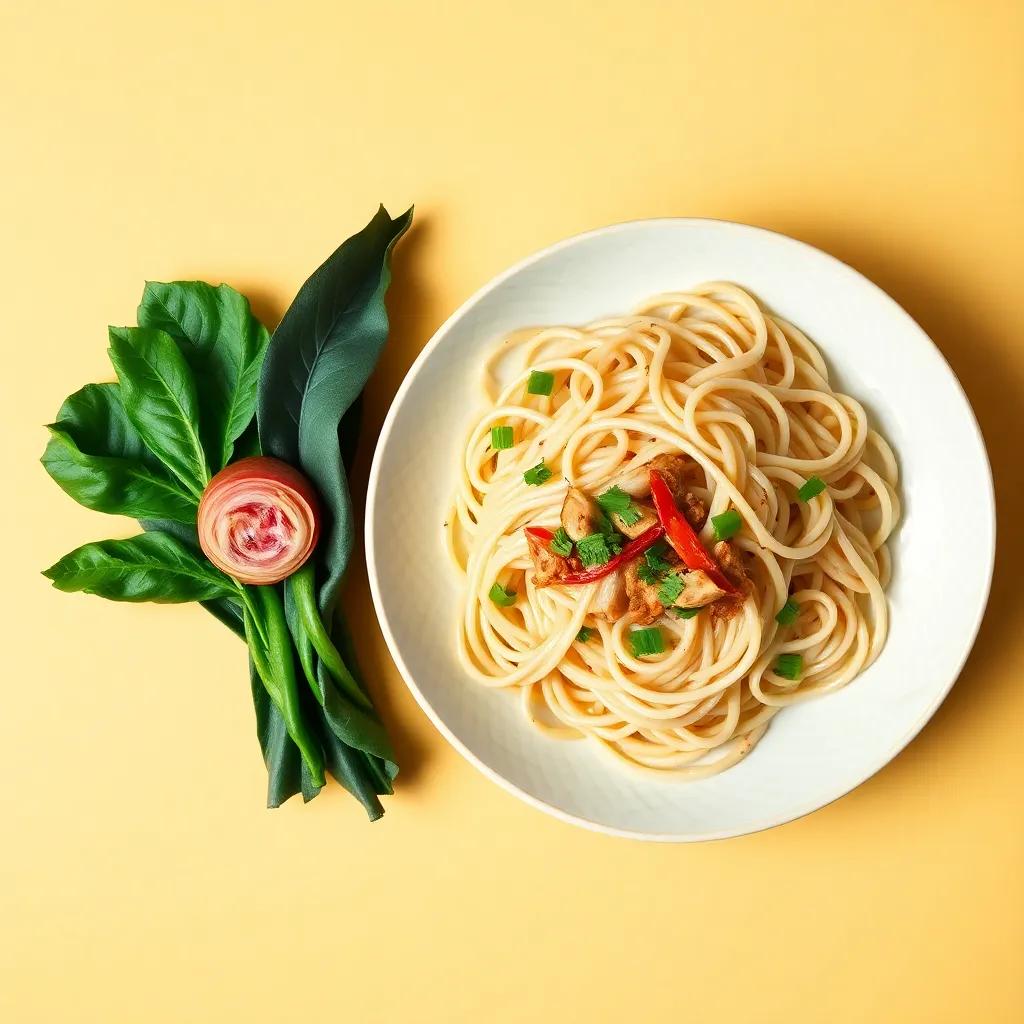
Ingredient Notes
When it comes to crafting the perfect lo mein, a few key ingredients elevate the dish from simple noodles to a flavorful, well-rounded meal. Understanding these standout components helps you know what to look for at the store and how to adapt if you need to.
Lo Mein Noodles
These are the heart of the dish. Traditionally made from wheat flour and eggs, lo mein noodles have a soft, slightly chewy texture that holds up beautifully to stir-frying. When shopping, look for fresh or dried lo mein noodles—fresh ones cook faster and have a tender bite, while dried versions are more pantry-stable but benefit from careful cooking to avoid mushiness. If you can’t find lo mein noodles, spaghetti or linguine are acceptable stand-ins; just be mindful of cooking times and texture differences.
Soy Sauce (Low Sodium Recommended)
Soy sauce provides the essential umami and salty backbone to the sauce. Choosing a low sodium variety helps control the dish’s saltiness, especially since other ingredients like oyster and hoisin sauce also contribute salt and sweetness. When buying, opt for naturally brewed soy sauce for richer flavor and avoid artificial-looking dark sauces that may contain added sugars and preservatives. If you need a gluten-free alternative, tamari is a great swap with a similar depth and complexity.
Hoisin Sauce
This thick, fragrant sauce adds subtle sweetness and complexity with hints of garlic, vinegar, and spices. It rounds out the savory notes from the soy and oyster sauces, giving the dish its signature glossy finish and slightly tangy undertone. Hoisin sauce can vary in intensity, so taste as you go. If you don’t have hoisin on hand, a small mixture of soy sauce, honey, and a touch of garlic or five-spice powder can mimic some of its flavor profile.
Toasted Sesame Oil
A little goes a long way with toasted sesame oil, which imparts a nutty aroma and deep flavor that instantly enriches the finished lo mein. It’s best added at the end of cooking or as a finishing drizzle to preserve its delicate fragrance. When buying, check that the oil is truly toasted (dark amber color) rather than plain sesame oil, which is milder and less aromatic. For allergy concerns or if sesame oil isn’t accessible, a light drizzle of toasted walnut or avocado oil can lend a subtle nutty note without overpowering the dish.
By paying attention to these cornerstone ingredients, you can confidently create a lo mein that’s both delicious and authentic-feeling. Plus, knowing your options ensures a smooth swap if you’re cooking with dietary restrictions or just working with what’s in your pantry.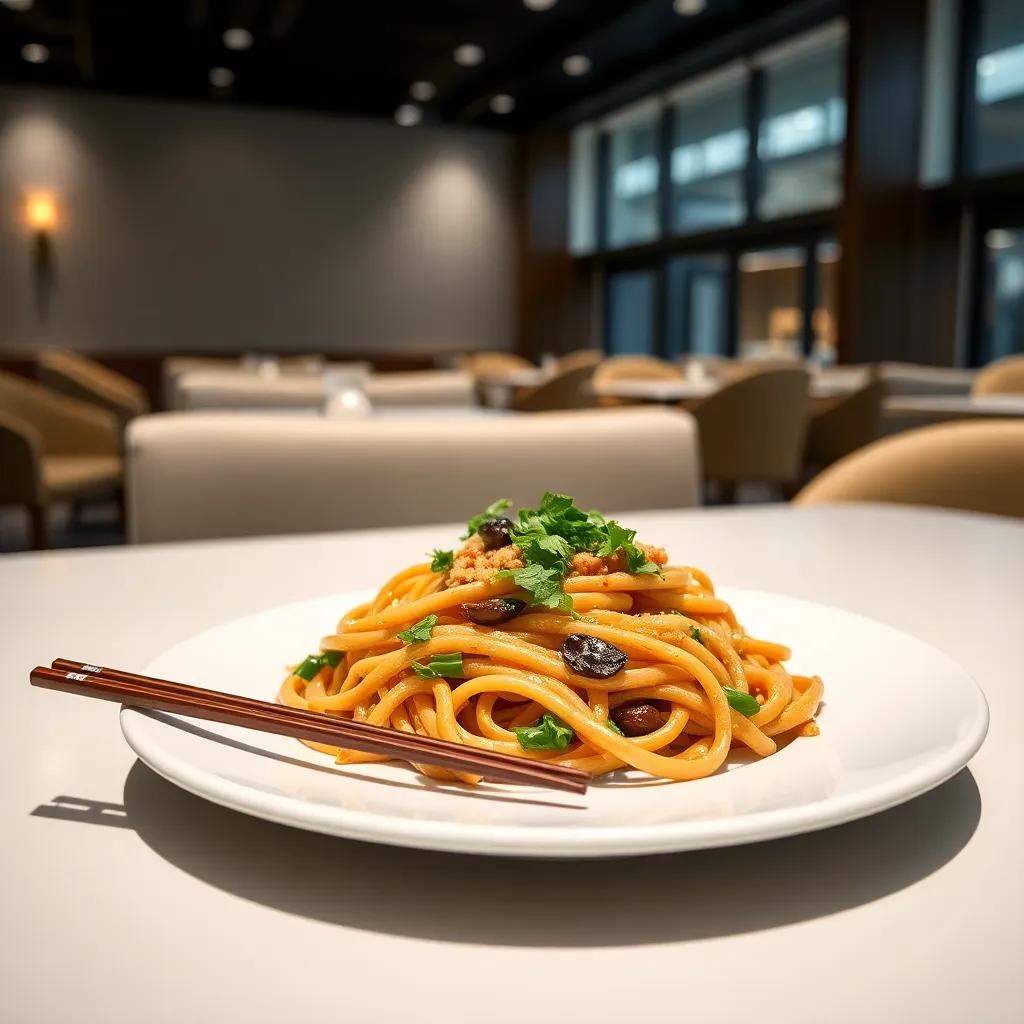
Tips & Variations
Mastering this 30-minute Lo Mein is all about balancing simplicity with flavor—and a few thoughtful tweaks can elevate your dish or adapt it perfectly to your needs. Here are some expert tips and creative variations to keep your stir-fry fresh, flexible, and fun:
- Noodle Know-How: To avoid mushy noodles, make sure to cook them just until al dente and rinse thoroughly under cold water to stop the cooking process and prevent sticking. If you’re short on traditional lo mein noodles, thicker spaghetti or even udon noodles offer a pleasantly chewy alternative. For a gluten-free option, try rice noodles or shirataki noodles—just reduce stir-fry time as these cook faster and can get limp.
- Maximize Sauce Flavor: The combination of soy, hoisin, and oyster sauce creates depth, but if you’re going fully vegan or avoiding shellfish, simply swap oyster sauce with mushroom-based vegetarian oyster sauce or a splash of miso. Adding a teaspoon of toasted sesame seeds or a few drops of chili oil right before serving can boost aroma and complexity. For a touch of brightness, a squeeze of fresh lime or a sprinkle of chopped cilantro can add a refreshing twist.
- Veggie Variations: This recipe is a perfect canvas for seasonal or preferred vegetables. Feel free to swap bell peppers for crunchy bok choy, shredded cabbage, or baby corn. Mushrooms—like shiitake or cremini—add a meaty texture that pairs well, especially if skipping eggs or meat. To keep the veggies crisp, add softer ones like tomatoes or zucchini last, just before serving.
- Protein Picks: While this recipe includes optional eggs, you can customize with shredded chicken, thinly sliced beef, shrimp, or tofu to boost protein content. Marinate meats briefly in soy sauce and a pinch of ginger for extra flavor. For a kid-friendly version, diced chicken or meatballs are great additions, keeping it familiar yet nourishing.
- Managing Heat Levels: The crushed red pepper flakes add a mild kick, but if you prefer a more vibrant heat, toss in fresh sliced chili peppers or a dash of Sriracha. Conversely, for gentle flavors suited to kids, omit the spice and highlight sweetness by adding a small drizzle of honey or a dash of orange juice.
- Cooking in Batches: Made in a large enough skillet or wok, this recipe scales well. Just keep an eye on stirring often to prevent sticking and ensure even cooking. If cooking for a crowd, prepare sauce separately and toss noodles and veggies just before serving to keep textures pristine.
- Enhance Texture and Garnishes: Complement the tender noodles and crisp vegetables with crunchy elements like roasted peanuts, cashews, or crispy fried shallots sprinkled on top. Fresh herbs such as Thai basil or mint also create an exciting flavor contrast.
By experimenting with these tips and variations, you can effortlessly tailor this lo mein to match dietary preferences, ingredient availability, or simply your mood—transforming a quick weeknight meal into a personalized comfort food celebration.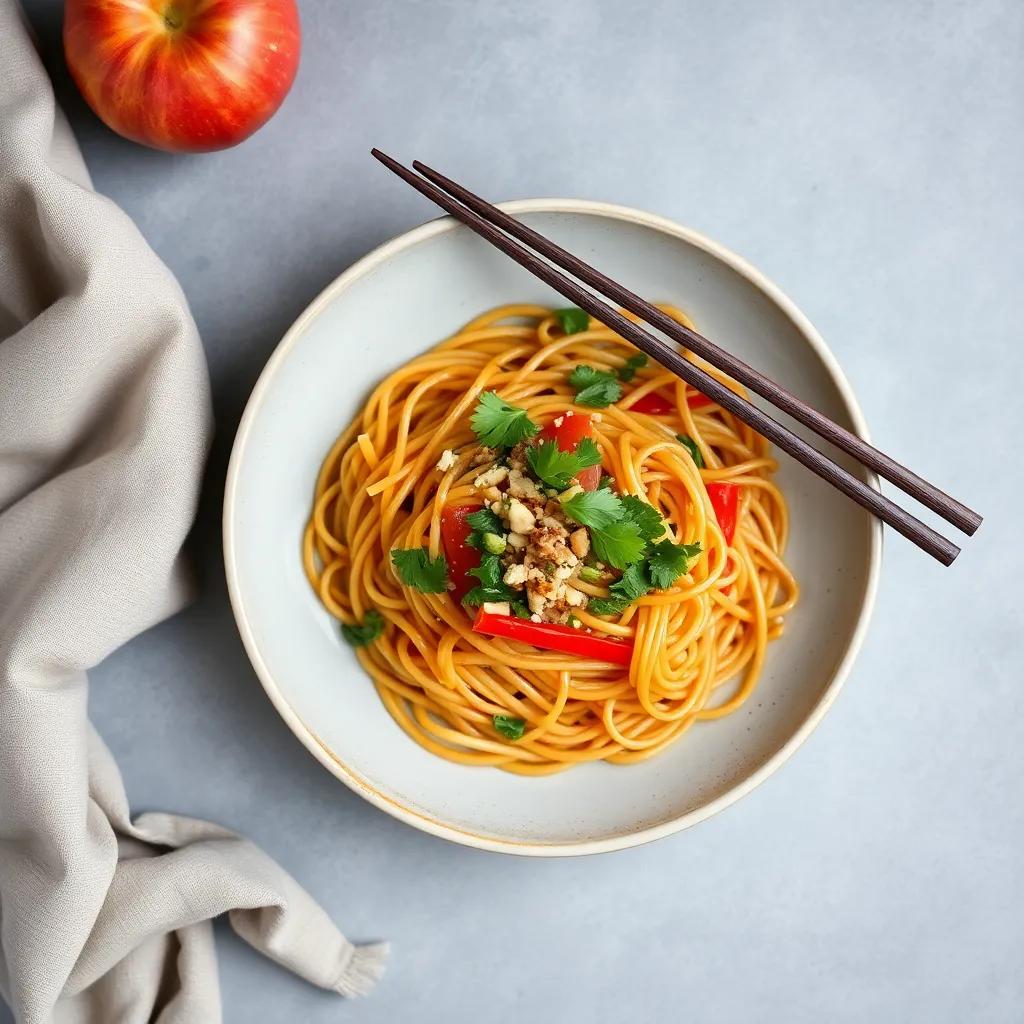
Leftovers & Storage
Leftover Lo Mein is a wonderful candidate for next-day meals, making it a convenient option for busy schedules or meal prepping. To keep your leftovers tasting fresh and maintain their ideal texture, proper storage is key.
Store any remaining lo mein in an airtight container as soon as it has cooled to room temperature—this prevents excess moisture buildup and slows down bacterial growth. Glass containers with tight-fitting lids are especially good choices because they don’t absorb odors and can go straight into the microwave or oven for reheating. If you prefer plastic containers, make sure they are BPA-free and seal well.
In the refrigerator, your lo mein will stay at its best for up to 3 to 4 days. Beyond that, the noodles may start to lose their chewiness and the vegetables could become limp. When reheating, add a small splash of water or broth to the dish and gently stir it while warming. This helps loosen the noodles and refresh the sauce, preventing the meal from drying out or sticking together.
If you want to extend storage further, lo mein freezes well for up to 2 months. Portion it into freezer-safe containers or heavy-duty freezer bags, removing as much air as possible to reduce freezer burn. Thaw frozen lo mein overnight in the fridge before reheating. While freezing can diminish the crispness of some veggies, the flavors should remain intact and satisfying.
For meal prep, this recipe’s balance of noodles, veggies, and optional eggs makes it a complete, hearty option you can pack for lunches. Use microwave-safe containers for easy reheating at work or school, and consider packing a small sauce packet or extra soy sauce on the side to brighten the flavors after warming.
Overall, with mindful storage and reheating, your leftover 30-Minute Lo Mein can be just as delightful the second time around—quick, flavorsome, and kid-friendly all over again.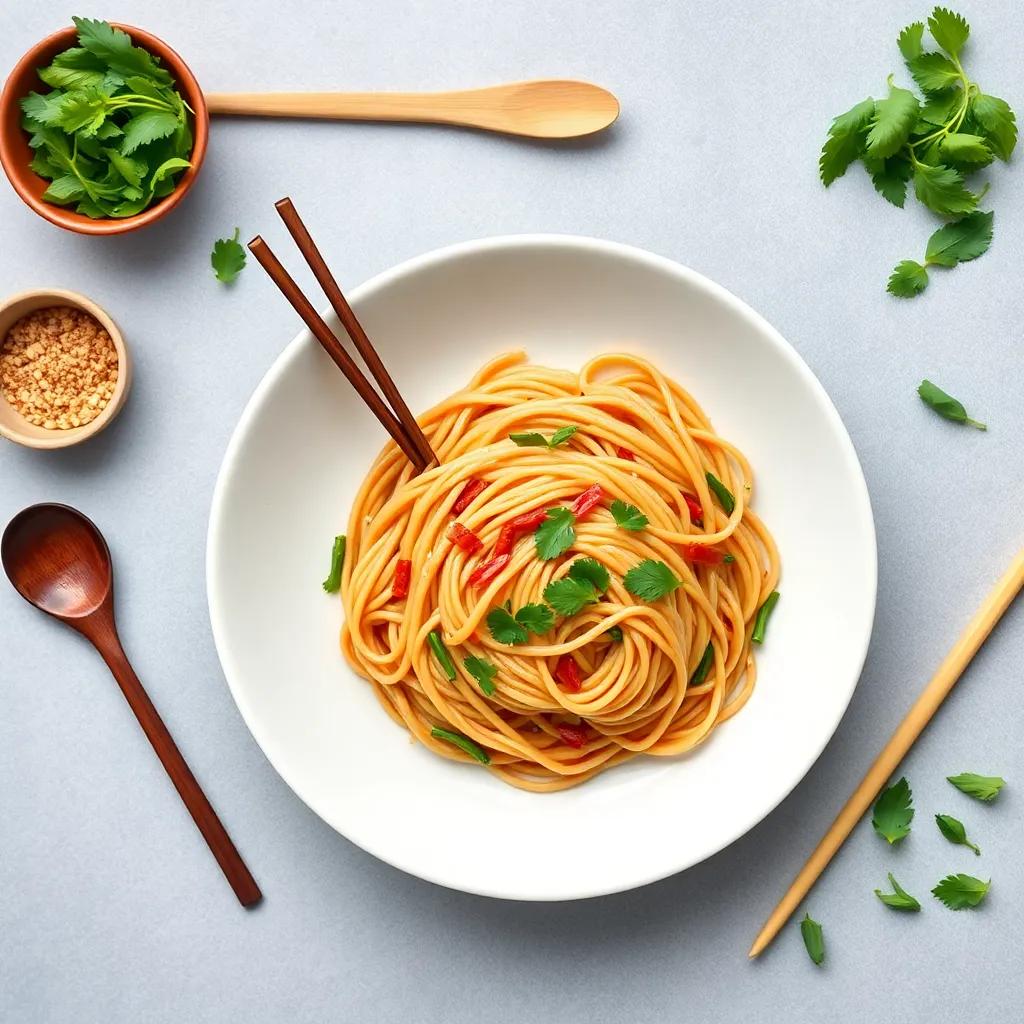
Behind the Recipe
Lo Mein is more than just a quick, tasty stir-fry—it carries a rich cultural history that adds depth to why this dish feels both comforting and special on your plate. Originating from northern China, the term “lo mein” translates roughly to “tossed noodles,” which perfectly captures the dish’s essence: tender noodles gently mixed with vibrant vegetables and savory sauces. Traditionally, lo mein recipes celebrate simplicity, making use of pantry staples and fresh seasonal produce, prepared swiftly over high heat to lock in flavor and texture.
This particular 30-minute rendition was inspired by the busy family dinners where ease and nourishment are paramount. Growing up around homemade Chinese dishes, the beloved lo mein was always a crowd-pleaser—especially with kids, thanks to its mild yet versatile flavor and colorful veggies that make it visually appealing. The recipe was adapted further to highlight flexibility: whether you’re a novice cook or looking to whip up a reliable weeknight meal, it respects tradition but embraces “what’s in your fridge” creativity.
What makes this version meaningful is how it bridges culture and practicality. The inclusion of egg adds a subtle richness reminiscent of home-style recipes, while the trio of sauces—soy, hoisin, and optional oyster—brings a balance of umami and sweetness found in classic Chinese takeout, without the wait or heavy oils. It’s a dish that honors its roots but invites you to make it your own, reflecting how lo mein has traveled from bustling street vendors and family tables in China to kitchens worldwide.
Ultimately, this recipe tells a story of accessibility and warmth, embodying how a humble noodle dish can connect generations, cuisines, and busy lives—making it a beloved staple easy enough to prepare anytime yet satisfying enough to feel like a special treat.
FAQ
Can I use tofu instead of chicken in this Lo Mein?
What’s the best way to store leftovers?
Can I freeze Lo Mein, or does it affect the texture?
Are there easy veggie substitutions or additions?
Can I make this recipe gluten-free?
How can I speed up prep time even more?
What’s a good protein alternative if I want something besides chicken or tofu?
Final Thoughts
There’s something truly satisfying about a meal that comes together quickly without skimping on flavor — and this 30-minute lo mein hits all the right notes. Whether you’re feeding picky eaters or just craving a cozy, homemade noodle dish, this recipe offers a perfect balance of ease and taste that’s sure to become a family favorite.
We’d love to hear how your lo mein turns out! Feel free to leave a comment, share your rating, or tell us about your own creative twists. After all, cooking is all about making a recipe your own, and we can’t wait to see what you come up with!

